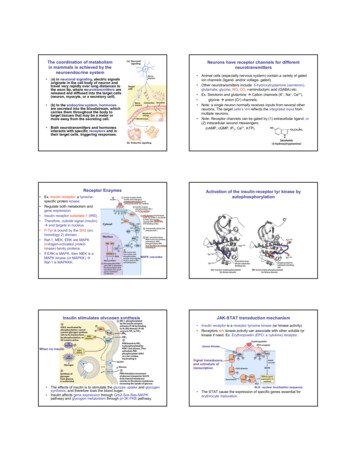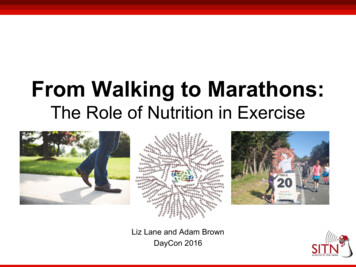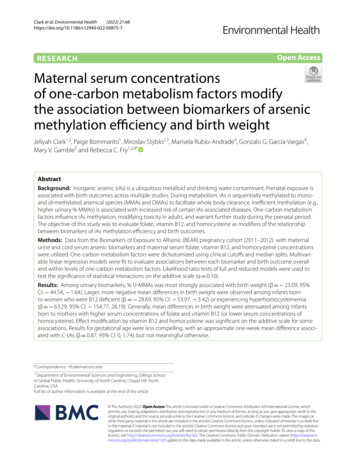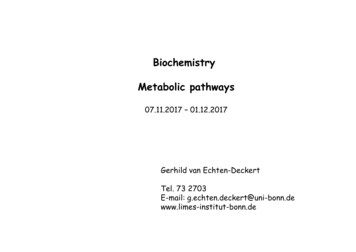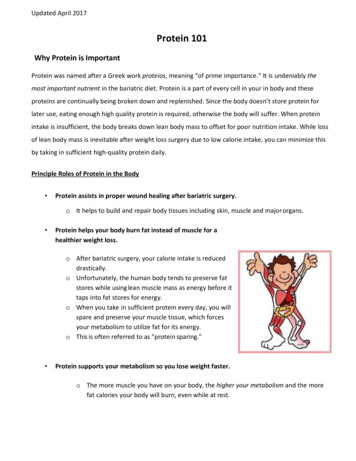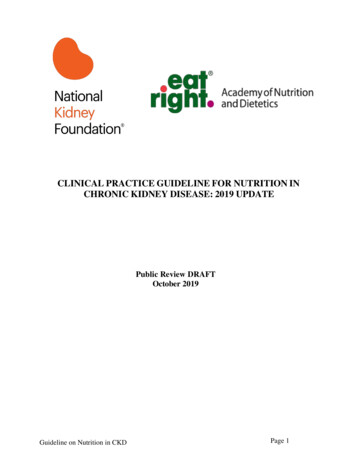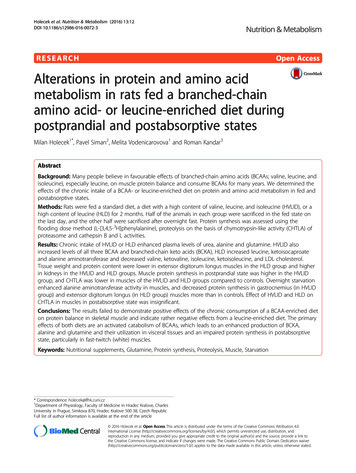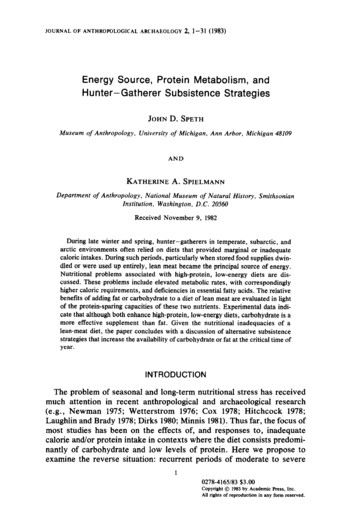
Transcription
JOURNALOF ANTHROPOLOGICAL2, 1-31 (1983)ARCHAEOLOGYEnergy Source,Hunter-GathererProtein Metabolism,andSubsistenceStrategiesJOHN D. SPETHMuseumof Anthropology,Universityof Michigan,Ann Arbor,Michigan48109ANDKATHERINE A. SPIELMANNDepartmentof of NaturalD.C. 20560History,SmithsonianReceived November 9, 1982During late winter and spring, hunter-gatherersin temperate, subarctic, andarctic environments often relied on diets that provided marginal or inadequatecaloric intakes. During such periods, particularly when stored food supplies dwindled or were used up entirely, lean meat became the principal source of energy.Nutritional problems associated with high-protein, low-energy diets are discussed. These problems include elevated metabolic rates, with correspondinglyhigher caloric requirements, and deficiencies in essential fatty acids. The relativebenefits of adding fat or carbohydrate to a diet of lean meat are evaluated in lightof the protein-sparing capacities of these two nutrients. Experimental data indicate that although both enhance high-protein, low-energy diets, carbohydrate is amore effective supplement than fat. Given the nutritional inadequacies of alean-meat diet, the paper concludes with a discussion of alternative subsistencestrategies that increase the availability of carbohydrate or fat at the critical time ofyear.INTRODUCTIONThe problem of seasonal and long-term nutritional stress has receivedmuch attention in recent anthropologicaland archaeologicalresearch(e.g., Newman 1975; Wetterstrom1976; Cox 1978; Hitchcock1978;Laughlin and Brady 1978; Dirks 1980; Minnis 1981). Thus far, the focus ofmost studies has been on the effects of, and responses to, inadequatecalorie and/or protein intake in contexts where the diet consists predominantly of carbohydrate and low levels of protein. Here we propose toexamine the reverse situation: recurrent periods of moderate to severe0278-4165183 3.00CopyrightAll tights0 1983 by Academic Press, Inc.of reproductionin any form reserved.
2SPETHANDSPIELMANNcaloric stress in contexts where carbohydrate intake is low, and whereprotein intake may at times provide as much as 85 or 90% of the totalcalories. In the following discussion we show that (1) many hunter-gatherersrecurrentlyrelied on protein as a principalsource ofcalories at certain times of the year, and (2) such reliance could lead tomarginal or inadequate energy intake and other nutritional deficiencies inthe hunter-gathererdiet. We examine the causes of these deficienciesand suggest subsistence strategies that would buffer hunter-gatherersagainst such potential periods of stress.Our concern is with periods of high lean meat (i.e., high protein) consumption, when carbohydrates and animal fat would have been scarce orunavailable to hunters and gatherers as sources of calories. We becameinterested in this situation when our research on late prehistoric and earlyhistoric adaptations in the Southern High Plains indicated that huntersand gatherers were adopting a variety of subsistence strategies in the latewinter and spring that avoided the consumption of lean bison meat (Speth1983; Spielmann 1982). Fat-depleted animals were avoided and lean cutsof meat were abandoned by hunters at spring-season kill sites despite thefacts that spring was generally a time of food scarcity in the region andbison was the only readily available subsistence resource. To better understand this seemingly paradoxical subsistence behavior, we turned tothe nutritional literature to determine if there were in fact serious problems associated with high lean meat intake that might compel hunter-gatherer populations to adopt alternative subsistence strategies.While our original concern was with hunters and gatherers in temperategrassland environments,this discussion also applies to hunter-gathererpopulations in other sharply seasonal environments (e.g., inland arctic,subarctic, northern deciduous forest). In environments such as these, latewinter and spring were often times of recurrent food shortage, hunger,weight loss, and starvation (for a few ethnographic examples, see Anastasio 1972; Bean 1972; Goldschmidt1951:417; Steward 1938:19-20, 27,46; Kelly 1964:22; Hodge 1907:51-52;Silberbauer1981:274-275;Gusinde 1961:284; Piddocke1965; Balikci 1968; Grinnell1972:258;Hayden 1981:414-415 and references therein; see also Wilmsen 1978;Truswell and Hansen 1968; Shephard 1974:287, 1980:329; Rode andShephard 1973: 172; Hgygaard 1941:68 for quantified examples of seasonalweight loss in hunter-gatherers).Recent studies in paleopathologydocument similar periodic nutritional stress in populations of prehistorichunters and gatherers, including those in so-called “nonmarginal”habitats (see Huss-Ashmore et al. 1982:434-450 and references therein;Buikstra 1976, 1981; McHenry 1968; McHenry and Schulz 1978; Cassidy1972).
HUNTER-GATHERERSUBSISTENCE3STRATEGIESIn late winter and spring, reliable alternative resources such as smallmammals, fish, and stored plant foods often became scarce or unavailable, and hunter-gatherershad to rely on large ungulate species for amajor part of their diet. It is precisely at this time of year, however, that adiet composed largely or entirely of ungulate meat may lead to caloric andother nutritional deficiencies because the ungulates themselves are experiencing nutritional stress and becoming fat-depleted.UNGULATECONDITIONAND ITS CONSEQUENCESHUNTER-GATHERERDIETSFORMale ungulates may lose up to 10 or 15% of their body weight during thefall rut due to high energy expenditure and reduced forage intake. As aconsequence, they often enter winter in comparatively poor condition. Ifnutritional shortages occur during winter, their body-fat reserves begin tobe depleted and their overall condition declines through late winter intospring. Females often enter winter with more reserves than males; theircondition therefore may be somewhat better in early spring. Later in thespring, however, pregnant or lactating females decline in condition to alevel below that of males. Thus, both sexes are in poorest condition in thespring, and both may have become severely fat-depleted (Allen 1979;Anderson ef al. 1972; Nordan et al. 1968; Peterson 1977; Pond 1978;Riney 1955; Sinclair and Duncan 1972; Binford 1978:40).With plant foods largely unavailable in this season, and in situationswhere stored carbohydrate reserves were nearly or entirely exhausted,the hunter-gathererdiet would have been composed mainly of proteinwith whatever fat remained in the meat. As the following ethnographicand historic accounts document, high reliance on lean meat can lead toserve nutritional stress. For example, Stefansson has described the deleterious effects of subsisting on the lean meat of rabbits in northernlatitudes. These animals are notoriously low in body fat, and reliance onthem for food leads to a conditionknown as “rabbitstarvation.”If you are transferred suddenly from a diet normal in fat to one consisting wholly ofrabbit you eat bigger and bigger meals for the first few days until at the end of abouta week you are eating in pounds three or four times as much as you were at thebeginning of the week. By that time you are showing both signs of starvation and ofprotein poisoning. You eat numerous meals; you feel hungry at the end of each; youare in discomfort through distention of the stomach with much food and you beginto feel a vague restlessness. Diarrhoea will start in from a week to 10 days and willnot be relieved unless you secure fat. Death will result after several weeks.(Stefansson 1944:234)Observationssimilar to those of Stefansson are commonin the ethno-
4SPETHANDSPIELMANNgraphic literature. The following examples further illustratequacy, in northern latitudes, of a diet based on lean meat.the inade-The quantity of food consumed at one meal naturally varies according to theamount of fat it contains. Men and dogs will half-starve on a diet of lean cariboumeat, however plentiful, whereas half the quantity of blubbery seal-meat willsatisfy their desires and keep them well nourished. (Copper Eskimo, Canada; Jenness 1923: 100)If people had only rabbits at such times they would probably starve to death,because these animals are too lean. The same might be true if they could get onlythin moose. People cannot live on lean meat alone, but if they have enough fat theycan survive indefinitely. (Kutchin, Alaska; Nelson 1973: 142)There are many similar observations in the ethnohistoric literature, andthese are by no means confined to the arctic. For example, Warren A.Ferris, while trapping in the Bear River Valley of Utah in 1830, made thefollowing observations concerning the poor sustenance provided by leanbuffalo.We killed here a great many buffalo, which were all in good condition, and feasted,as may be supposed, luxuriously upon the delicate tongues, rich humps, fat roasts,and savoury steaks of this noble and excellent species of game. Heretofore we hadfound the meat of the poor buffalo the worst diet imaginable, and in fact grewmeagre and gaunt in the midst of plenty and profusion. But in proportion as theybecame fat, we grew strong and hearty. . . . (Phillips 1940:42)Jedediah Smith led a group of trappers along the Klamath River inCalifornia in May 1828. According to Dale Morgan (cited in Allen1979:457),. . . the party made only 3 miles on the 18th, which taxed their strength to theutmost. ‘The men were almost as weak as the horses, for the poor [spring] venisonof this country contained little nourishment.’Finally, Randolph B. Marcy in the winter of 1857-1858 provided an illuminating comment regarding the inadequacy of a diet based on fatdepleted meat.We tried the meat of horse, colt, and mules, all of which were in a starved condition, and of course not very tender, juicy, or nutritious. We consumed the enormous amount of from five to six pounds of this meat per man daily, but continuedto grow weak and thin, until, at the expiration of twelve days, we were able toperform but little labor, and were continually craving for fat meat. (Marcy I863:16)Of particular interest arehunters avoided or abandonedfavor of fatter animals, evenfood. A typical example was1804.frequentanimalswhen therecordedreferences to situations in whichthey considered too lean for use inhunters themselves were short ofby Lewis and Clark in DecemberCaptain Lewis went down with a party to hunt. They proceeded about 18 miles; butthe buffalo having left the banks of the river they saw only two, which were so pooras not to be worth killing. . . (Coues 1893:Zll)
HUNTER-GATHERERIn Februarydiary.SUBSISTENCE5STRATEGIES1805 Lewis and Clark made another,similarentry in theirCaptain Clark returned last evening with all his hunting party. During their excursion they had killed 40 deer, 3 buffalo, and 16 elk; but most of the game was too leanfor use. . . (Coues 1893:233)As a final example, Jacob Fowler, during his expedition to the RockyMountains of Colorado, made the following comment in his journal inFebruary 1822.Hunters out Early-Killedone Cow Buffelow With In four Hundred yards ofCamp-but so Poor the meat Was not Worth Saveing. . . . (Coues 1898:97; spellingas in original)To summarize, the above data indicate that a diet composed largely oflean meat (i.e., mainly protein with small amounts of fat), even in quantities that would appear to satisfy caloric requirements, can result in serious nutritional problems. Hunters apparently were keenly aware of thedeleterious effects of a lean-meat diet, and, when possible, abandonedlean animals for fatter ones, even when they were short of food (see alsoJochim 1981:81 and Hayden 1981:394-398 for discussions of the importance of fat in hunter-gathererdiets).PROTEIN METABOLISMThe nutritional literature provides interesting insights into the reasonswhy diets composed largely of lean meat should have the negative effectsdescribed in the above quotes, and suggests which alternative sources ofenergy should be preferentiallysought to supplement such a diet. Webriefly review pertinent aspects of this literature to (1) delineate severalkey problems peculiar to meeting caloric needs under high-protein, lowenergy diets, and (2) derive a series of subsistence activity responseswhich hunter-gatherersmay be expected to make to cope with periods ofadequate protein intake but caloric deficiency.Specific DynamicActionOne aspect of protein metabolism relevant to this issue concerns thehigh “specific dynamic action” (SDA) of protein ingestion. The SDA offood refers to the rise in metabolism or heat production (diet-inducedthermogenesis) resulting from the ingestion of food (Chaney and Ross1971:45; Briggs and Calloway 1979:32; Barnes 1976: 12- 13; Houssay et al.1955:455-456; Taylor and Pye 1966:39-40; Guthrie 1975:94-95; Bigwood 1972:xxii; Rothwell and Stock 1979; Wing and Brown 1979:22;Bourliere 1964:336). The SDA of a diet consisting largely of fat is about6- 14%, while that of a diet high in carbohydrates is about 6%. In striking
6SPETHANDSPIELMANNcontrast, the SDA of a diet consisting almost entirely of protein may be ashigh as 30%; or, in other words, for every 100 calories of protein ingested,up to 30 calories are needed to compensate for the increase in metabolism.Thus, persons whose diets are high in protein experience higher metabolicrates than those whose diets are composed largely of carbohydrate. Forexample, members of Eskimo populations, at least 90% of whose caloricneeds were traditionallymet by meat and fat (cf. Draper 1980:263;Hoygaard 1941), had basal metabolic rates 13 to 33% above the DuBoisstandard, which is based on the metabolic rates of populations consumingwestern diets (Itoh 1980:285).In a series of experiments, Long (1946) demonstrated that elevatedmetabolic rates such as those observed among the Eskimos are not solelya response to low arctic temperatures (see also Rodahl 1952; LeBlanc1957). He observed significant increases in the rate of heat productionwith the administrationof high-protein diets over a considerable range ofair temperatures, and irrespective of the type or amount of clothing wornby the subjects in his experiments.Similarly, two arctic explorers, V. Stefansson and K. Andersen, in astudy conducted in the temperate environs of New York, subsisted for anentire year on an all-meat diet. With an intake of lean meat (ca. 3% fat),the increase in their metabolic rate varied from 14.6 to 25.0% above basallevels. In one test the increase was 45.3%. On a diet in which fat providedabout 75% of their calories, the increased heat production ranged from 8.6to 22.3% (McClellan et al. 1931; McClellan and DuBois 1930). It may beconcluded from these data that heavy or complete reliance on fat-depletedmeat would have elevated the total energy needed to support a group ofhunters at a time of year when total caloric intake was very likely to havebeen restricted.If we examine the caloric requirements of body maintenance, i.e., thecalories needed for basal metabolic functions, ingestion of food, and protein balance, the impact of a high-protein diet on basic caloric needsbecomes evident. Table 1 provides two different estimates of basal metabolic rates for an adult male weighing 53 kg and an adult female weighing46 kg. These weights, based on FAOlWHO developing country standards(1973:82), are below the standard weights for industrialized countries andare assumed to be representative of hunter-gathererbody weights. Theestimates of basal metabolic rate do not include energy expended formetabolic processing of food (SDA), and thus an additional energy increment amounting to about 20% of the basal rate, a median figure based onthe ranges of SDA values given above, must be added to estimate caloricrequirementsunder conditions of high protein intake. Thus, as the“Total” column in Table 1 indicates, under a high-protein diet, simply tomaintain the calories necessary for basal metabolism and the metabolic
HUNTER-GATHERERBASIC UIREMENTSUNDERA 3051830Female4613502701620Female4613382681606n Basal metabolicb Specific BMWPayne(1972:303)FAO/WHO(1973: ng of food, an adult male requires about 1800- 1900 k&day,andan adult female about 1600 kcallday. In comparison to a more balanceddiet, whose SDA would be between about 6 and 10% rather than 20%(Briggs and Calloway 1979:32; Guthrie 1975:95), a diet composed almostentirely of lean meat requires at least 9% more calories to satisfy the samebasic metabolic and physiological functions. As the above studies indicate, SDA values approaching 30% are not uncommon on all-meat diets,and at these levels at least 18% more calories are required to meet basicmetabolic needs.We can translate these caloric requirements into estimated per capitadaily quantities of lean meat consumed. However, to do this we must firstprovide quantitative estimates of the percentage fat content of meat fromwild animals, and particularly of meat from animals at the low point oftheir annual cycle of condition. In the present discussion we will concernourselves entirely with large ungulates such as deer, antelope, caribou,and bison. These and other large mammals were principal targets of hunter- gatherer procurement activities. The importance of specific smalleranimals during the winter and spring will be considered later.Standard food composition tables, such as Watt and Merrill (1963), areof limited utility in this endeavor. First, very few wild ungulates havebeen investigated by food scientists, because these animals play an insignificant nutritional role in the modem world. Values for the amount of fatin meat of cattle, sheep, and other domestic species are far more numerous in the literature, but these figures are inappropriatein the presentcontext since domestic animals have undergone centuries or millennia ofselective breeding in favor of high levels of fat. In addition, domesticanimals are often fed supplemental rations during seasons of low natural
8SPETHANDSPIELMANNforage availability, and many are fattened on high-protein or high-energy“finishing”rations just prior to slaughter.For the relatively small number of wild ungulates that have beenanalyzed, often only a single value is reported, and seldom is there anyindication given as to whether this value represents a specific muscle ormeat cut, or a composite of several cuts (e.g., “venison” of deer). Thesestudies also rarely indicate the sex of the animals analyzed, nor do theyreport the reproductive status of the animals at the time of slaughter (i.e.,whether pre- or post-rut in males; whether pregnant, lactating, or barrenin females). Furthermore, most published values are derived from animalsthat presumably were slaughtered while in peak condition, whereas in thepresent context we are most concerned with animals at their annual lowpoint in condition.It should be pointed out, however, that the few minimum values that doexist for wild ungulate meat may nevertheless tend to underestimatesomewhat the actual amount of fat available to hunter-gatherersin acarcass, because the values do not include subcutaneous and visceral fatdeposits, fat in the bone marrow, and so forth. On the other hand, as willbe discussed more fully below, many of these fat reserves may becomelargely or totally depleted during the winter and spring, bringing the available fat levels more in line with the values for meat alone.In contrast to the nutrition literature, studies in wildlife biology havebeen very much concerned with the fat levels of wild ungulates. Theamount of fat in the carcass of an animal, such as a deer or antelope,provides a very useful indicator of its overall condition, and thereforeplays a critical role in management practices (cf. Harris 1945; Riney 1955).Wildlife specialists have devised a series of expedient indices (e.g., kidney fat index, thickness of backfat, girth measurements) which permitthem to estimate condition in the field without having to resort to far morecostly and time-consumingquantitative laboratory determinationsof actual fat content (cf. Riney 1955). Unfortunately,these indices are verydifficult to translate into data comparable to the percentage fat values ofmeat provided by nutritionists.In a few cases total carcass fat has also been determined, either bydensitometric techniques or by analyzing samples from homogenized carcasses. These whole-body estimates provide a reasonably accurate measure of the total amount of fat in the carcass. However, the whole-bodyfigures overestimatethe amount of fat generally available to hunter-gatherersby including lipids, such as bone grease, that are verycostly in terms of time and labor for hunters to extract from the carcass.An additional problem arises in using data from the wildlife literature.To obtain large sample sizes, data collected over several months, or evenover several years, are frequently pooled. The resulting averages tend to
HUNTER-GATHERERSUBSISTENCESTRATEGIES9obscure the impact of below-average years on the condition of the animals; and it is the minimum fat levels that are most critical to the subsistence behavior of hunters and gatherers.Table 2 provides comparative data on the fat levels of several large wildungulates that are known to have been of importance to hunters andgatherers in various parts of the world. Entries are included only whendata are available in the form of percentage fat content. This unfortunately eliminates the bulk of observations on wildlife in which overallanimal condition is assessed only by means of fat indices. It should alsobe noted that techniques for extracting fat have improved over the years;as a consequence, some of the values from the earlier studies listed inthe table may tend to underestimate actual fat levels.Despite the obvious shortcomings of the data presented in Table 2, theydo indicate that “minimum”fat levels in the meat of many wild ungulatesmay reach extremely low values in the winter and spring (or in the late dryseason and early rainy season in arid tropical areas). Most values areprobably less than 2%, and it may not be uncommon for levels to dropbelow 1%. Moreover, many of the principal fat deposits in an animal maydisappear completely, and others may be largely depleted (Harris 1945;Riney 1955; Ransom 1965; Sinclair and Duncan 1972; Pond 1978). Forexample, Anderson (1981:74) notes that in Colorado mule deer, “subcutaneous fat was entirely lacking in mature males and near minimal inmature females during winter.” Harris (1945) made similar observationsin a study of both white-tailed and mule deer in the Black Hills of SouthDakota. In many of the deer he examined, the subcutaneous fat had beentotally depleted by mid-February and by the end of the month fat depositsin the body cavity, including fat around the intestines, kidneys and heart,also had been completely mobilized. Dauphine (1976) observed that 100%of the backfat in the average adult barren-ground caribou had been depleted by spring, and that 70% of the abdominal fat had been mobilized. Inadult Scottish red deer stags, rump fat disappeared entirely, and infemales was reduced to negligible levels (Mitchell et al. 1976). Trout andThiessen (1968) reported that 80% of the mule deer collected in late winterand spring in southwestern Idaho were in poor condition. They describedthis condition class as having no subcutaneous fat, less than 10% of theintestines covered by mesentary fat, and kidney fat totally depleted orpresent only in small patches. Stockle et al. (1978) observed zero percentfat levels during the spring around the kidneys and heart in 15-18% ofmale white-tailed deer and in approximately10% of female white-taileddeer collected from various localities in the southeastern United States.Adult male elk in Michigan had little or no visceral fat following the rut(Moran 1973).Significant reduction of fat levels in bone marrow has also been re-
)americana)(0. hemionus)(0. hemionus)(0. hemionus)(0. hemionus)(0. hemionus)(0. hemionus)(0. sspp.)spp.)(0. Antilocapra(Antilocapra(AntilocapraCattle (Domestic)(Bos fuurus)(Bos raurus)(Bos taurus)@OS raurus)AntelopeAnimalVenison, leanVenison, leanHam loinHam loinWhole-body (M)Whole-body (F)Whole-body (M)Whole-body (M)Whole-body (F)Whole-body ody (Steer)Whole-bodyWhole-bodyWhole-bodyPart ciated?Seasonkilled6.04.04.50.94.96.016.9 k 7.15.4 k 1.712.5 ” 3.26.9 3.17.7 k o/TABLE 2PERCENTAGEFATCONTENTOF SELECTED WILD UNGULATESetetetetetetal. (1949)al. (1949)nl. (1949)al. (1949)al. (1949)al. (1949)Chattield (1940)Watt and Merrill (1963)Cook et al. (1949)Cook et al. (1949)Anderson et al. (1969)Anderson et al. (1969)Anderson et al. (1972)Anderson et al. (1972)Anderson et al. (1972)Anderson et al. (1972)Weiner (1973)CookCookCookCookCookCookKeys et al. (1950)Keys et al. (1950)Pearson et al. (1968)Garrett (1968)
andus)tarandus)tarandus)Bison(Bison archFallFallFall?March?Hump (M)Rib steak (Steer)BreastComposite, h (1970), Ledger (1968)Smith (1970), Ledger (1%8)Smith (1970), Ledger (1%8)Smith (1970), Ledger (1968)Mann et al. (1962)Berkes and Farkas (1978)Schaefer (1977)Morris et al. (1981)Dickinson (1976)Wilber and Gorski (1955)Deethardt (n.d.)Mann et al. (1%2)Farmer er al. (1971)Schaefer (1977)Berkes and Farkas (1978)Wo and Draper (1975)
12SPETHANDSPIELMANNported in many ungulates. Anderson er al. (1972), for example, observedmean spring-season fat levels of 3 1.9% ? 28.0 in male mule deer femora.Values of less than 20% were reported by Ratcliffe (1980) in the femoraand humeri of a small sample of roe deer. Comparably low fat levels werenoted by Stockle et al. (1978) in southeastern white-tailed deer femoraduring the spring. Alabama white-tailed deer femora from animals visuallyassessed to be in poor condition had a mean fat content of 27.0% 5 7.32(Baker and Lueth 1967). Greer (1968) reported fat levels of less than0.25% in femora of winter-killed elk. He also observed values of less than1% in live elk collected during the spring. Franzmann and Arneson (1976)recorded an average fat level of 8.5% - 4.1 in femora of winter-killedmoose. Finally, although no actual figures are provided, Peterson (1977)found that bone marrow was almost totally fat-depleted in moose fromIsle Royale, Michigan that had died of malnutritionduring the late winterand spring.We can now return to our original objective of determining the daily percapita quantity of lean meat that hunter-gathererswould have to consume in late winter and spring to fulfill their basic caloric requirements.Based on the discussion above, the meat of wild ungulates at the low pointin their annual cycle of condition probably ranged in fat content from aslow as 0.9% to a maximum of about 1.5-2.0%. Although the major fatdeposits most readily accessible to hunter-gatherers(i.e., subcutaneousand visceral fat) may be largely if not entirely depleted at this time of year,there may be smaller amounts of fat remaining in places such as the bonemarrow which, while labor-intensive to extract, will augment the total fatintake. Thus, we will assume that the average amount of fat available tothe hunters ranges between about 2 and 3%. The protein content of meatis relatively constant at about 21% (cf. Watt and Merrill 1963).Table 3 provides estimates of the number of kilograms of meat necessary to meet the basic daily caloric requirements for adult males andfemales that were presented in Table 1. Given a diet composed entirely oflean meat (2-3% fat), a male would have to consume between 1.7 and 1.9kg (3.7-4.2 lb.) of meat per day, and a female between 1.5 and 1.6 kg(3.3-3.5 lb.) simply to satisfy basic metabolic needs.These estimates do not include calories for any form of physical activity. inclusion of calories to cover physical activity will substantially raisethis need, especially since hunting requires high energy expenditure(Shephard 1974:284). For example, both summer and winter caribouhunting among traditional Canadian Eskimos require approximately3600kcal per 24-hour period (Shephard 1978:51). To meet these energy needs,a hunter would have to consume between 3.4 and 3.6 kg (7.5-7.9 lb.) oflean meat per day. It is important to keep in mind that the increase inhunter-gatherercaloric requirements just outlined is occurring during a
HUNTER-GATHERERSUBSISTENCETABLE13STRATEGIES3DAILY LEAN-MEAT REQUIREMENTS UNDER A HIGH-PROTEIN DIETSexBasic caloricrequirement(kcal/day)MaleFemale1830- 19201600Lean meat@(2% fat)(W-W1.8-1.91.6Lean mear(3% fat)(kg/day)1.7-1.81.5n Adipose tissue (fat and moisture), 7.5 kcal/g; protein, 4 kcal/g (McLarenRodahl and Issekutz 1965:8).1981:32,season in which ungulate body weight has declined, and hence the takeper animal is reduced. Moreover, herds in the spring may be widelydispersed or highly mobile in response to reduced forage availability.Thus, locating subsistence resources may become particularly difficult atthis time of year and require much greater amounts of strenuous activity.Finally, there is evide
benefits of adding fat or carbohydrate to a diet of lean meat are evaluated in light of the protein-sparing capacities of these two nutrients. Experimental data indi- cate that although both enhance high-protein, low-energy diets, carbohydrate is a more effective supplement than fat.

